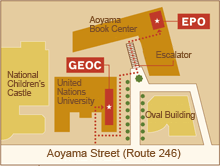Overview
The nonprofit organization (NPO) Toyonaka Citizens Environmental Conference Agenda 21 is a promoting actor. In 1996, through a partnership between citizens, business operators and government, the “Toyonaka Citizens Environmental Conference” was inaugurated as an organization to deal with environmental problems. In 1999, “Toyonaka Agenda 21” was formulated as a citizen action plan. The objective is to promote it together with the city’s administrative plan (the “Toyonaka City Environmental Master Plan”) formulated in the same year. The agenda is comprised of 88 action proposals (revised from 101 such proposals in 2005), with implementation being promoted on behalf of regional society and local citizens, as well as future generations. For the promotion, numerous ventures are being developed by the Toyonaka Citizens Environmental Conference Agenda 21 NPO, and are listed below.
Overall activities:
● Toyonaka citizen environmental exhibits (held since 1992)
● Eco-SUN citizen electrical generation (Shimin {citizens’} cooperative electrical generation venture)
● Publishing of the newsletter “Toyonaka’s Environment” (originally published from 1996 as the “Toyonaka Citizens Environmental Conference Newsletter”; current name adapted in 2002)
● Operation of environmental study sessions
Project activities:
● Bamboo charcoal project (Recycling bamboo)
● Kikakuya-Honpo (Planners shop) project (Thinking about the environment while having fun)
● The Flowers & Greenery Network – Toyonaka (Through the composting of raw garbage, focusing on the food cycle and raising flowers)
● Global warming countermeasures project (Implementing the Toyonaka City regional plan for global warming prevention)
● ‘The Ai-ai project’ (A hands-on environmental education program)
Committee activities:
● Lifestyle committee (promoting eco-friendly lifestyles)
● Nature committee (educating people on becoming more familiar with, and protecting, the environment)
● Enterprise committee (promoting more environmentally-conscious enterprise)
● Transportation committee (promoting activities intended for operators of public transportation and shipping-related businesses)
Points about the partnership
● In 1997, set up a citizens association, held discussions over the next 1½ years, and then in January, 1999, mapped out the concept of “co-action” for the first time in Toyonaka City. Rather than the simple idea of “administrative reform = cutting people”, they instead took the view that government and citizens together help create a good environment. Aiming for a ‘Participation→ Participatory planning→ Co-action’ process, set up an information-sharing, open-door policy.
● Article 19 of Toyonaka City’s environmental basic ordinance (promulgated in 1995), which citizens recognize, serves as the foundation for the rule-making in “co-action”.
● Promotes projects aimed not only at citizens, but also at business operators. Strives to create a system which encourages participatory planning by diverse actors.
Category
Based on subsidies and grants from government and business operators
Theme
Other(Sustainable regional development / Creation of a recycling-based society)
Actors
The nonprofit organization (NPO) Toyonaka Citizens Environmental Conference Agenda 21
Partners
Toyonaka City, citizen’s groups, business enterprises, labor unions, etc.
Relevant website
Toyonaka City official website – “Information on citizens’ environmental activities”
http://www.city.toyonaka.osaka.jp/top/kankyou/shiminkankyokatsudo/agenda21/simin_kaigi.html

















